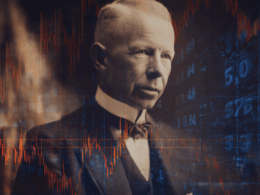It takes a special kind of arrogance to believe that the market can continue defying gravity indefinitely. Yet, here we are, with the S&P 500 up over 26% last year, mega-cap tech stocks gobbling up a dispoportionate 35% of the index, and valuations stretched so far beyond historical norms that even the most hardened bulls are starting to check their parachutes. If this is the market’s new normal, one can’t help but wonder: what happens when the AI euphoria meets economic reality?
Tech’s Stranglehold on the Index
Ryan Nicholl, Vice President and Portfolio Manager at Dynamic Funds, doesn’t mince words.1 "What we've had the last two years is two consecutive years of the same thing, which is essentially a tech driven bull market where the largest mega cap tech companies keep getting bigger and bigger. And that's kind of unique in history. We're at the point now where the top eight stocks, which are entirely tech stocks or tech related, are now 35% of the US market index, the S&P 500. That's an incredible level."
Unique—and dangerous. As Nicholl points out, the AI-driven rally has created two major issues:
(1) a market increasingly vulnerable to a correlated selloff, and
(2) an illusion of high valuations at the index level, distorting investment decisions. "The S&P 500 [is] trading about 22 times earnings. That's quite elevated versus history. History would be more like a 16 to 17 times earnings multiple. The MSCI World Index, which is the main global index, is at this point now 75% constructed with U.S. stocks."
"If you can look different, there's a lot of opportunities right now," Nicholl observes. "If you need to look like the index, you're gonna look expensive."
Avoiding Speculative Landmines
Jason Gibbs, Vice President and Portfolio at Dynamic Funds, isn’t here to gamble. "There's two things. You can either be an investor or a speculator. And, obviously, speculating is not what we do. And when you're speculating, you're just taking a guess at where prices will or not go, and that's not what we do."
The lesson from history? Momentum-driven markets don't end well. "You never know how long these periods can go. When you are in a situation where securities are relatively expensive, you can be patient."
That sounds like wisdom, but it’s also a stark warning. This cycle will break. When it does, the winners won’t be the ones riding AI hype to its peak, but those who positioned for reality rather than illusion.
Where the Smart Money Is Going
If not tech, then where? Nicholl has a shortlist: healthcare, consumer staples, energy, and financials.
"Healthcare I've always thought is the highest quality of the defensive sectors because their economic moats are incredibly wide, they have very predictable demand for their products and their secular growth in the aging theme."
The broader market may be overvalued, but not everything is priced for perfection. "Financials had a good year last year, but they kinda just kept up with the market and on a relative basis, they're still pretty cheap."
This isn’t about avoiding growth—it’s about buying real, tangible cash flows at a discount, rather than chasing ephemeral AI dreams.
The Case for Canada? Really?
If you’re looking for contrarian bets, consider this: Tom Dicker, Vice President and Portfolio Manager at Dynamic Funds, thinks Canada might finally be investable again. "The sentiment on the Canadian economy is really, really bad right now. And I think some of that is well deserved, but much of the bad news may be priced in already."
He’s got a point. U.S. equities have run hard, while Canada’s relative valuations have plummeted. "We're at the point now where it looks very apparent that we're gonna have an election in Canada this spring, we're gonna have a change in government. It is much likelier that twelve months from now we'll be looking at a much more business friendly environment in Canada."
Power, AI, and the Coming Energy Crunch
Gibbs delivers the most striking insight of all: North America is running out of power.
"It is one of the greatest long term themes that I've seen in quite a while in the sense that North America and many parts of the world, simply put, are short power. They don't have enough power. And we have had underinvestment in power infrastructure, particularly the last two decades."
"So what does that mean? It means there's gonna be more demand for volumes with respect to power, and it also means that all else equal, power prices are going higher."
The solution? "Owning independent power producers. So those are the companies that own power plants. And also regulated utilities."
AI: Tool or Tyrant?
While AI is inflating the market’s biggest bubble, it’s also quietly revolutionizing investing. "Our process and the way we learn about companies has changed more in the last twelve months than it did in my prior twenty years in this business," Dicker admits.
Dynamic Funds is already using AI tools like Perplexity and Quartr for research, transcript analysis, and automating data-heavy tasks. "So in terms of things that are available out there that we use, we use Perplexity Pro. What we've found is what large language models are most usable for. So the frontier models like ChatGPT, Google Gemini, their language models, they're good for language problems."
"Eventually, all investors will be using products like this," Dicker predicts. And in a few months? The entire AI landscape could look completely different. "The quality and the power of these models is changing so quickly."
Conclusion: The Bubble Always Bursts
The Dynamic Funds team isn’t naïve. They see the risks. They see the stretched valuations. And they see where the money should actually be flowing—defensive sectors, energy, financials, and power infrastructure.
Will AI fundamentally change the world? Probably. But does that justify paying 22x earnings for an index dominated by eight companies with eerily correlated risks? Absolutely not.
At some point, the market will rediscover discipline. When it does, those positioned for tangible, cash-flow-driven returns will be the ones left standing. As for the speculators? History has a way of dealing with them.
Footnote:
1 "Equity Income Landscape in 2025 – Dynamic Funds." 21 Feb. 2025, https://dynamic.ca/en/insights/commentary/podcasts/7-2-25-tdicker-jgibbs-rnicholl.html.
Copyright © AdvisorAnalyst.com, Dynamic Funds













